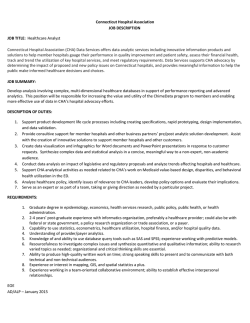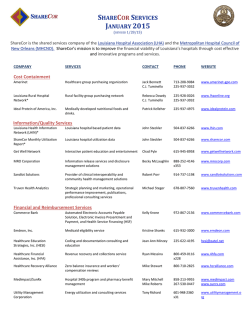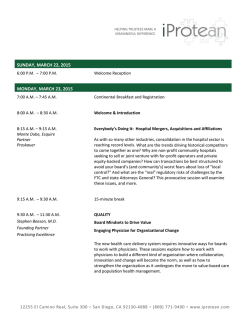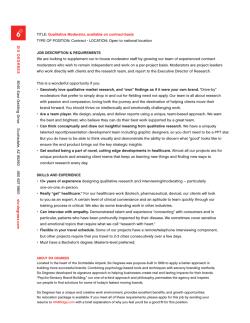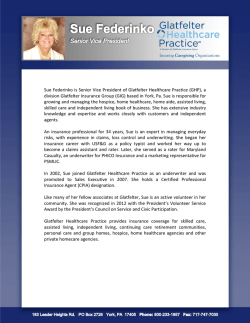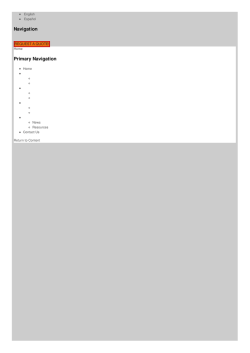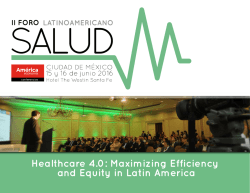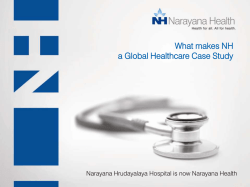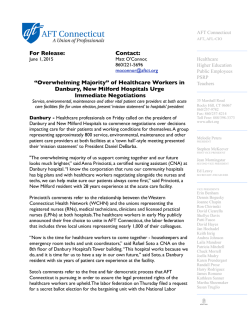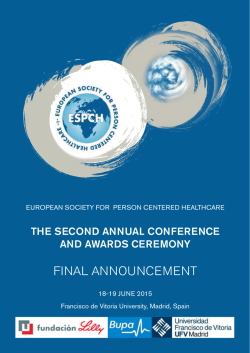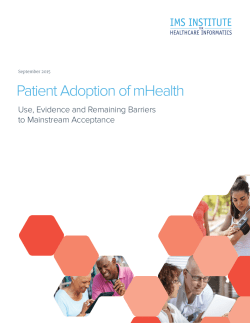
2015 Social Media Healthcare Report
2015 Social Media Healthcare Report THE POWER OF SOCIAL MEDIA TO TRANSFORM OUR MEDICAL EXPERIENCES Produced by Sponsored by Executive Summary Introductions are made, water bottles and cups of cofee are passed, and business cards are exchanged. It’s time to start the meeting. The PR Director leads of with a familiar tone and perspective. “We’re so frustrated. Our executives don’t get it. They don’t get social. They don’t understand what it is, how it works, and why what we’re doing is so important. We’re seeing the numbers rise, but they don’t want to invest more resources in our approach. They want to spend more on billboards, print, and TV, but these are expensive and limited. We have no idea if or how well they’re working to educate our patients or help people choose our services.” The story above is common. It relects the value question of social-digital media from an executive and marketing angle. But the most important perspective in the conversation is missing - the patient’s perspective. This report is an efort to address these kinds of conversations. We present the latest information on the use of social-digital-mobile media in the context of a true patient story. IN THIS REPORT 1 Digital engagement among healthcare professionals Top digital capabilities the healthcare industry lacks 3 Likelihood of information from social media afecting health decisions Beneits of digital and social environment to both the consumers and the health care providers 5 02 04 How health care providers can best participate in the social media model KEY FINDINGS + The most common experience shared via social platforms is the positive care received at a hospital or medical facility. + Social media has raised patient expectations around response time. About 70% expect a patient service response within 24hrs. + 41% of patients are using social media to choose a speciic hospital or medical facility. + 55% of patients trust information via social media from Hospitals, and 39% are willing to share it. + Facebook is No.1 platform for most patients (66%) to share information or ask questions from healthcare providers and pharmaceuticals. Why single out the medical industry? This statement is all too common... “WE’RE SO FRUSTRATED. OUR EXECS DON’T GET IT. THEY DON’T UNDERSTAND WHAT IT IS, HOW IT WORKS, AND WHY WHAT WE’RE DOING IS SO IMPORTANT. WE’VE SEEN THE NUMBERS RISE, BUT THEY DON’T WANT TO INVEST MORE RESOURCES IN THIS APPROACH.” Hospitals who aren’t committed to social media lose opportunities with connected patients One father’s perspective My wife, Veronica, heard a strange sound on the baby monitor - silence. She was used to hearing our two year old son, James, snore heavily during his afternoon nap. Startled by the sound of silence, she ran upstairs to check on him. Veronica quietly opened his door to see him standing up in his crib. She immediately noticed his face, hands and feet were an unnatural color of blue. She frantically searched around his crib for a blue marker to explain the discoloration, but couldn’t ind one. As she brought him to the changing table to wipe the coloring of of him, he began to fuss and the blue coloring disappeared. What in the world had just happened? She called his pediatrician to learn more. It turned out, James had just experienced cyanosis. The name cyanosis, literally means “the blue disease” or “the blue condition.” It is derived from the color cyan, which comes from kyanos, the Greek word for blue. Cyanosis can be fatal if an intervention isn’t made within 3-5 minutes. Knowing James’ medical history of severe obstructive sleep apnea (152 episodes per hour) and having had several surgeries to open his airways, the pediatrician agreed with James’ team of doctors that the next step to his healing would be a tracheostomy. He proceeded to suggest an immediate surgery, fearing we might not be so fortunate if cyanosis happened again. Veronica and I had a huge decision to make and only about 12 hours to make it. This level of urgency forced us to use social media and phone calls to the people we trusted most. We needed to receive unbiased, brutally honest, feedback of their experiences or stories they heard. We love our kids more than anything, and would lay down our lives for their well being - and that’s exactly what we wanted in a hospital staf. We expected to hear stories about the patient experience from the provider - but were unable to ind them. Interestingly enough, our friends spoke only of the patient experience, and how they, or their kids, were treated during their stay. They told honest stories of their experiences in the hospital; stories of remarkable kindness and generosity, but also of selish workers with poor attitudes. It was a simple choice for us: We chose the hospital whose staf and volunteers would sellessly love James like we would - and they delivered. -- Excellent healthcare providers claim they’re patient centered. If this is true, where are the patient stories? One father’s perspective (cont.) As expected and hoped for, the surgery was successful. James was on his way to complete health and being able to enjoy life to the fullest. Before his tracheostomy, he was in the 0.4th percentile for weight, and 9 months later, in the 50th. He had extraordinary energy and was able to make up ground on his development. It’s amazing what sleep can do! “I’ve learned that people will forget what you said, people will forget what you did, but people will never forget how you made them feel.” - Maya Angelou. We couldn’t help but tell the stories from our experience. When the chef in the cafeteria knew his name and made silly faces to cheer him up, they cheered me up. When our time limit for being outside was up, they extended it because they noticed how much he was enjoying the normalcy of feeling like a kid again. They gave my older son a doll with a trach and taught him what life would be like for a little while, so he wouldn’t be afraid of seeing his brother’s new way of life - sounds like something a loving parent would do too, right? There are opportunities every second of every day to make a lasting impact on the patient. It’s a choice to be selless, and a choice to overcome the fear of rejection. It requires you to be vulnerable enough to connect with your person and make a remarkable emotion in their life they’ll never forget. Sharing these moments are what draw people in. “I’ve learned that people will forget what you said, people will forget what you did, but people will never forget how you made them feel.” - Maya Angelou. Hospitals and healthcare organizations are telling us a story; a story that says they care about about our health. But, they aren’t telling us stories about how they care for people. We expect them to care for our health, but we choose them because of their selless love and care for us. The solution is simple: capture real stories and moments of sincere connection between people and their hospital, and share them with the world on social media. It’s these stories of kindness and generosity that are your biggest inluence and greatest diferentiator. We’re in the connection economy: Whoever connects, wins. Be more human and less corporate. Rick Warren said it well, “True humility isn’t thinking less of yourself, it’s thinking of yourself less.”. After all, this kind of relationship is why we’re choosing you, and it’s the story we’re telling others. Misunderstanding or misrepresenting on social media fractures the patient journey Future patients will increase use of apps, social media, online reviews and other digital platforms for their medical decisions. If patient stories need to be told and the majority of patients (55%) are engaged on social media, then start here... Capture and Share Capture real stories and moments of sincere connections between people and their hospital, and share them with the world on social media. Follow these four steps: 1 2 3 4 Never Assume Don’t assume that doctors, executives, or board members understand these practices or their impact. Educate them. Structure for Stories Structure communications to capture and curate story-driven content based on both patients and medical staff (e.g. internal journalist(s) Publish Effectively When publishing personal-patient stories, ensure the effective use of search engine (SEO) optimization and calls-to-action. Get Analytical Include analytics and insights tracking as part of all digital efforts, and report to executives in a meaningful way to show value. Report Contributors Alex Kitchens | Insights Andy Roller | Editor Annie Argarwal | Research Brandon Lozano | Written Chelsea Lozano | Written Joshua Godsey | Design Special Thanks Bethany Kilgore, TCU Neeley School of Business Pam Stoker, TCU Neeley School of Business Wini King, Cook Children’s Hospital Harriet Harral, Leadership Fort Worth Paul Spiegelman, Stacy Palmer, Natalie McKay, he Beryl Institute Amanda O’Neal, he Brummitt Group Contact us We’ll assess your online presence and offer recommendations. Start Here We believe stories, data-driven insights, clear goals, meaningful effort, and fun are good for our team, good for our clients, & good for the marketing industry. • Social Media • SEO • Sites [email protected] www.expioconsulting.com 888-227-9903
© Copyright 2026
